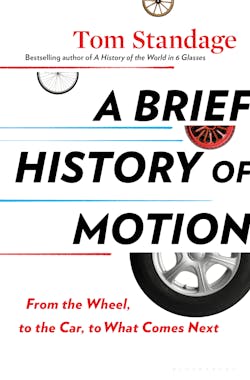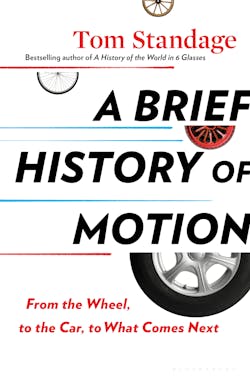Unleash the ultimate freedom of personal vehicle ownership: mobility, convenience, and ease. Complaints about pollution, congestion and safety were becoming an environmental nuisance, and society demanded solutions. That was the late 1880s.
Noisy horse-drawn coaches overcrowded muddy roadways and the foul stench of manure piles were transmitting diseases. Even worse, horses might kick somebody or bolt unexpectedly into Neverland.
When multiple vehicle technologies converged onto the European and American streets, the developing nations welcomed it as a lifetime fix, writes Tom Standage, author of “A Brief History of Motion.” Ultimately, the internal combustion engine beat out the steam engine and electric vehicle at the turn of the 20th century.
It’s come full circle in the 2020s, Standage observes in his richly documented history of personal transport, that critics of personal car ownership questioned the harmful climate ramifications created by traffic, noise and pollutants. “What looks like a quick fix today may well end up having far-reaching and unintended consequences for tomorrow,” warns Standage.
At the dawn of gas-powered automobiles, a handful of people pondered the unforeseen outcomes of what the environment might appear in later generations. Today’s government policymakers and climate-change experts are asking if an automobile is worth owning. Globally speaking, Standage explores if drivers would be willing to trade in their wheels forever for something else —namely digital apps — and still preserve mobility and independence.
Curiously, though, Standage bypasses the automotive aftermarket’s longstanding presence in the car-centric U.S.A. Regardless of his oversight, this industry should take note of the detailed retelling of the automobile’s contribution to American culture, which has paved anything but a straight path.
Ever since this country’s rapid embrace of motorized vehicles, the driving public’s romance with fast cars has been associated with cruising seemingly endless roads. Thanks to mass production by Ford and easy financing by General Motors, widespread vehicle usage inspired novel innovations that generations of automobile owners now take for granted. Think of roadside gas stations, which turned into service repair facilities that spawned convenience stores appearing on major routes. Drive-in movie theatres and drive-through fast-food joints amplified the concept of instant gratification long before the handheld iPhone app supercharged on-demand ordering of virtually anything.
“Cars and the freedom and the independence they provided,” Standage writes, “were central to the teenage culture that began to take shape in the 1940s.” Simple fast convenience, the catchphrase software platforms often use, he suggests was a byproduct of the introduction of the competing modes of technology.
Who in the 1920s during the swift adoption of Ford and General Motors models would ever have predicted the revival of the electric vehicle? Its battery stored disproportionately less energy than the fuel tank for the internal combustion engine, whose output allowed vehicles to travel further at greater ranges. Even though EVs did not emit exhaust and were easier to operate with fewer mechanical parts, the ordeal of swapping out clunky lead-acid batteries put limits on people’s craving for freedom and adventure.
“What looks like a quick fix today may well end up having far-reaching and unintended consequences for tomorrow.” — Tom Standage, author of "A Brief History of Motion: From the Wheel, to the Car, to What Comes Next"
EV’s nascent comeback to overtake diesel and fuel engines also has a dirty side, notes Standage. Electricity generation relies heavily on burning coal that he says accounts for 40 percent of carbon dioxide emissions. Extracting rare earth minerals carries geopolitical risks, including child labor. Inside the Democratic Republic of Congo, “around a quarter of the production is done by hand, using shovels and torches” to mine cobalt, which in turn China refines. Yet upon this book’s publication, China, not the Western nations, controls the lion’s share of computer chips needed to power EVs.
Repeatedly from the starting pages, “A Brief History of Motion” sounds a cautionary message that no singular kind of vehicle transport replacement will resolve every societal issue, simply because tradeoffs can be difficult to manage.
Self-driving autos have facilitated access to the disabled and the very old who cannot drive a car. Despite advancements in artificial intelligence, fatalities have occurred. Things still can go badly. “Many predictions made about the driverless car sounds eerily familiar to those in the early days of the horseless carriage,” writes Standage.
Meanwhile, smartphones and e-commerce subscription services have reordered the global car parc onto roads unknown. Ride-hailing services by Uber and Lyft, despite a fall in ridership during the coronavirus, have led teenagers to give pause about obtaining a driver’s license. Buying goods online for home delivery has made ease and convenience pretty much the norm.
Accordingly, industry leaders are responding to a shrinking vehicle population. Standage quotes the CEO of Robert Bosch, one of the aftermarket’s largest parts suppliers, saying, “It could be that we passed the peak of automotive production.”
But the potential good news is that the auto manufacturing base has entered the realm of disparate business models bundled into one. Personal automobile ownership may matter less to the manufacturers, due in part to the emergence of Mobility-as-a-Service. The three-way mash-up between smartphones, open data and online payments is upending the traditional model of selling automobiles, asserts Standage. Instead, the carmakers view selling rides as the profit maker. They see fleets owned by car-sharing and ride-hailing operators as its new customer segment.
Yet that, too, brings a downside to all. Streaming data reveals who went where, an unresolved issue about the limits of personal privacy for the sake of Mobility-as-a-Service. Anxieties about unauthorized surveillance becoming an abuse by companies and governments are now a hotly debated topic.
Put together, this paradigm shift behooves the automotive aftermarket to monitor where these global car parc trends are headed. “Total car sales each year is up around $2 trillion,” estimates Standage. “But the personal transport market, which includes vehicles, services, and software, is worth more like $10 trillion, according to industry estimates.”
Great news? Perhaps be wary of what might appear beyond each blind corner. Placing all bets on smartphone tech to become the lasting personal mobility begs the historical question that “A Brief History of Motion” brings to the forefront. Innovations like on-demand transportation may hatch unplanned circumstances big and small, which is why Standage urges all riders to buckle up with open eyes on the road ahead.




